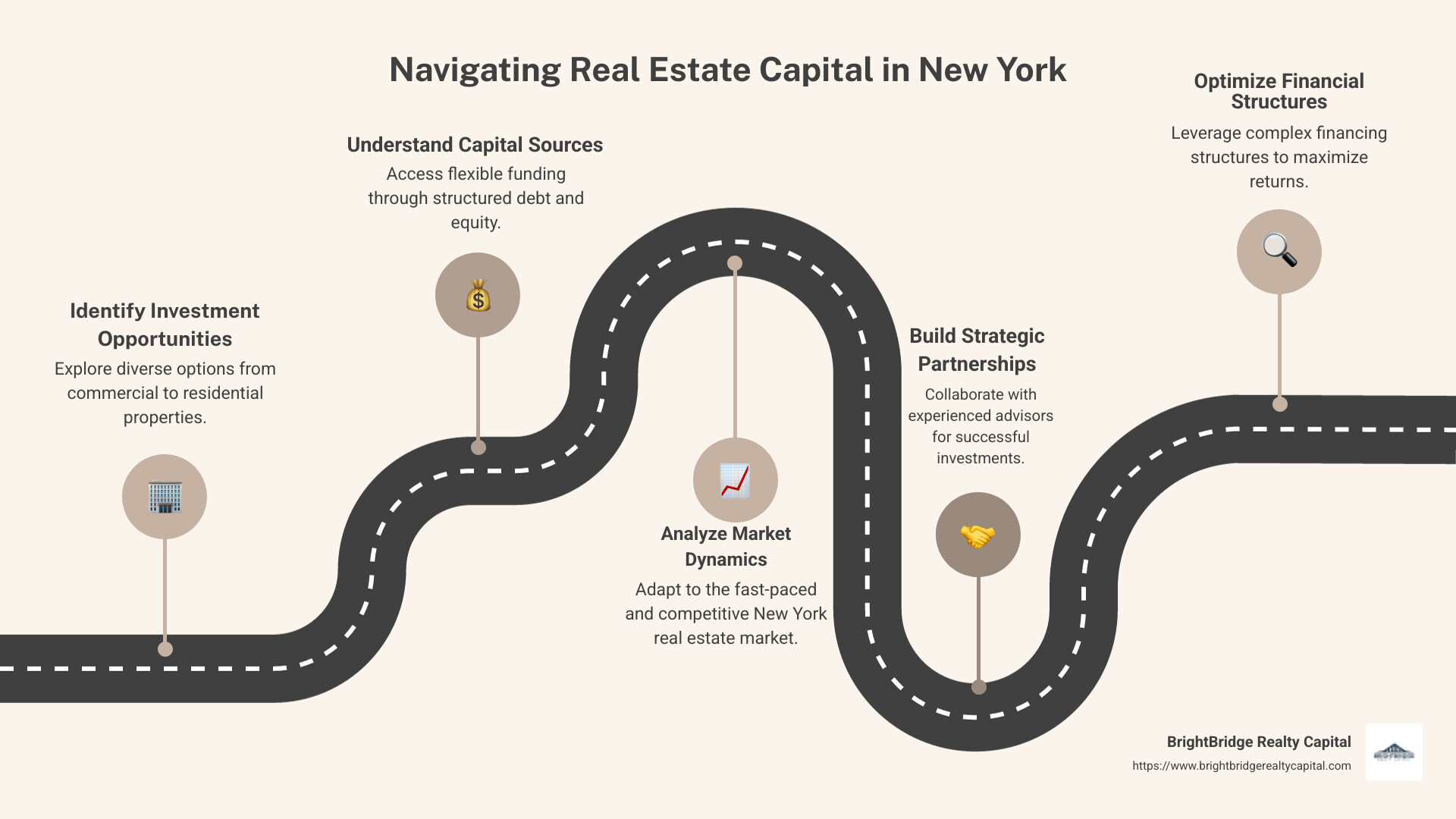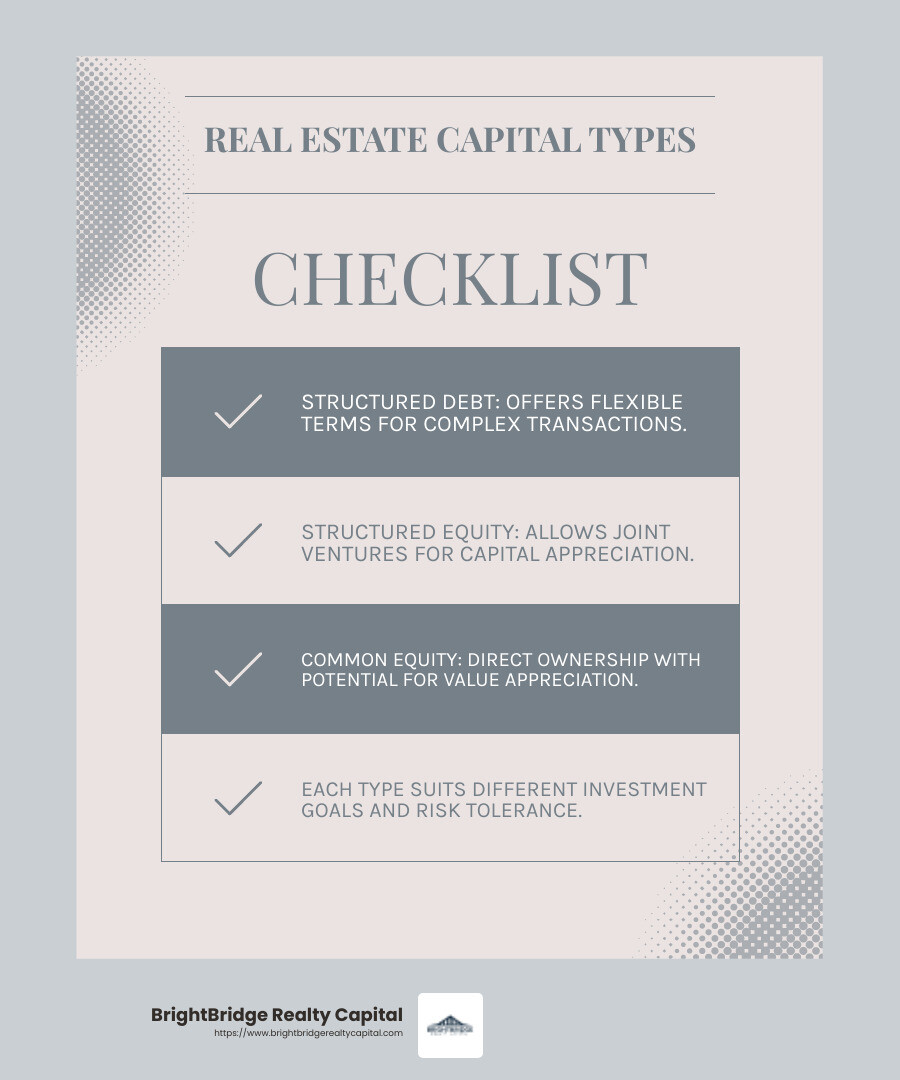New York Real Estate Capital: Top Options for Investors

Real estate capital New York is a vibrant and critical component of the city's busy investment landscape. As a key gateway and growth market, New York offers diverse opportunities for both novice and experienced real estate investors. The potential to secure competitive financing and optimize your capital stack is immense.
Here’s a quick snapshot to get you started:
- Location: New York is one of the top locations for real estate investment due to its extensive market size and international appeal.
- Investment Opportunities: From commercial to residential properties, the city offers a myriad of options custom to different risk appetites.
- Capital Sources: Access to flexible funding through structured debt and equity, mezzanine loans, and joint venture equity.
- Market Dynamics: Fast-paced and highly competitive, calling for experienced advisors and strategic partnerships.
For those seeking investment opportunities in one of the world’s most dynamic real estate markets, understanding the intricacies of real estate capital in New York is essential. This environment is not just about transactions; it's about building relationships and navigating through complex financing structures to realize significant returns.
In the sections that follow, we'll dig deeper into the unique capital options available and the strategies investors can employ to make the most of the New York real estate market.

Understanding Real Estate Capital in New York
In the busy world of real estate capital New York, understanding the capital structure is crucial. The capital structure refers to the mix of debt and equity that funds real estate investments. This balance is key to maximizing returns while managing risk.
Gateway markets like New York are considered prime locations for investment. These markets are characterized by their large, diverse economies and their appeal to both domestic and international investors. New York, as a gateway market, offers stability and a high potential for appreciation. This makes it a magnet for institutional investors and high-net-worth individuals looking for safe and lucrative opportunities.
Growth markets, on the other hand, are areas with rapid economic expansion and population growth. Within New York, certain neighborhoods and boroughs are emerging as growth markets. These areas offer higher risk but also higher reward potential. Investors often look to these markets for opportunities to get in early and benefit from future appreciation.
In New York, investors can tap into various capital sources, including structured debt, structured equity, and common equity. Each of these options plays a role in constructing a robust capital stack that aligns with the investor's strategy and risk tolerance.
- Structured Debt: This involves loans with customized terms to meet specific investment needs. It's ideal for projects that require custom financing solutions.
- Structured Equity: This provides flexibility in terms of investment duration and return expectations. It's often used in partnerships where capital appreciation is a key goal.
- Common Equity: This represents ownership in a property. It's a straightforward investment but carries the risk and reward associated with property value fluctuations.
In this dynamic market, understanding these elements of real estate capital New York is vital for making informed investment decisions. The right mix of capital can open up significant opportunities and drive substantial returns in both gateway and growth markets.
Top Real Estate Capital Options in New York
When investing in real estate capital New York, it's important to understand the different capital options available. Here, we'll break down three key types: structured debt, structured equity, and common equity.
Structured Debt
Structured debt is a flexible financing option custom to the unique needs of each real estate project. This type of debt often comes with customized terms, making it ideal for complex transactions or projects requiring specific financing conditions.
For example, stretch senior loans are a form of structured debt. These loans offer higher leverage than traditional senior loans, which can be crucial for projects in gateway markets like New York. This allows investors to access more capital upfront, facilitating large-scale developments or acquisitions.
Structured Equity
Structured equity provides more flexibility than traditional equity investments. It allows for various hold periods and return expectations, making it suitable for investors looking for capital appreciation.
In New York, structured equity often involves joint ventures. In these arrangements, investors partner with experienced developers or property managers to maximize returns. This collaborative approach can lead to innovative projects that benefit from the expertise of all parties involved.
Common Equity
Common equity represents direct ownership in a property. This is the most straightforward type of investment, where returns are directly tied to the property's value.
Investing in common equity in New York's real estate market can be lucrative due to the city's potential for appreciation. However, it also comes with risks, as property values can fluctuate based on market conditions.
Understanding these options is crucial for investors aiming to leverage real estate capital New York. Each type of capital offers distinct benefits and risks, allowing investors to tailor their strategies to their specific goals and risk tolerance. This flexibility is key to navigating the dynamic real estate landscape in New York.

Key Strategies for Real Estate Investment
When investing in real estate capital New York, leveraging the right strategies is essential. Here, we'll discuss some key strategies: flexible capital, customized solutions, and risk-adjusted returns.
Flexible Capital
Flexible capital is about having the ability to invest in various parts of the capital structure. This means being able to move quickly and adapt to different market conditions. For instance, BrightBridge Realty Capital demonstrates how flexible capital can be utilized across different property types and markets in the U.S. This flexibility allows investors to seize opportunities as they arise, whether it's a new property acquisition or a redevelopment project.
Customized Solutions
Every real estate project is unique, and having customized solutions is crucial. This approach involves tailoring financial products to meet the specific needs of a project or investor. BrightBridge offers custom terms for equity investments, ensuring that each deal aligns with the sponsor's business plan. This customization can make a significant difference in the success of a project, as it ensures that the financial strategy supports the overall goals.
Risk-Adjusted Returns
Investors must consider risk-adjusted returns to ensure that they're getting the best possible outcome for their investment. This involves evaluating potential returns against the risks involved. In New York, where the real estate market can be volatile, focusing on risk-adjusted returns helps investors make smarter decisions. By balancing risk and reward, investors can aim for sustainable growth and protect their capital over time.
Implementing these strategies can help investors steer the complex world of real estate capital New York. By focusing on flexibility, customization, and risk management, investors can better position themselves for success in this dynamic market.
Frequently Asked Questions about Real Estate Capital New York
What is real estate capital?
Real estate capital refers to the funds used for investing in properties. It can come from various sources like banks, investment funds, or private investors. In New York, a busy hub for real estate, capital is crucial for acquiring, developing, and managing properties. Investment managers play a key role in overseeing these funds, ensuring they are used effectively to generate returns.
How does real estate capital financing work?
Real estate capital financing involves securing funds to purchase or develop properties. In New York, this can include both commercial property and multifamily property investments. Financing options might include loans, equity partnerships, or a mix of both. The goal is to create a capital stack that supports a project's financial needs. For example, a multifamily building may use a combination of senior loans and equity to fund its purchase and renovation.
What are the benefits of investing in New York real estate?
Investing in New York real estate offers several advantages. The city is home to high-quality offices and a vibrant market with numerous deal opportunities. This means investors can find properties that promise good returns. Additionally, New York's real estate market is known for its resilience and potential for long-term growth. Whether investing in commercial spaces or multifamily units, the city offers a diverse range of opportunities for both seasoned and new investors.
Conclusion
In the busy world of Real estate capital New York, having a reliable partner can make all the difference. At BrightBridge Realty Capital, we specialize in providing swift and flexible funding solutions custom to your investment needs. Our commitment to fast closings—often within a week—ensures you never miss out on valuable opportunities.
What sets us apart is our approach to direct lending. By cutting out intermediaries, we offer competitive rates and a seamless, hassle-free process. This means you can focus on what matters most: growing your investment portfolio.
Whether you're looking to flip properties, start on new construction, or expand your rental holdings, our team is here to guide you every step of the way. With our expertise and dedication, we aim to be your trusted partner in navigating the dynamic New York real estate market.
For more information on how we can support your real estate ventures, visit our BrightBridge Realty Capital service page. We're ready to help you bridge the gap to success.



